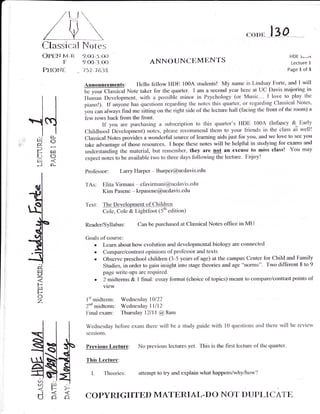Lecture 1
- 1. / v /U Classical Notes Opctq v-a 9-{O*J--OO .oou l3O HDE - i..*'a F 9{O*3{}3 ANNOUNCI'MtrNTS Lecture 1 PHONE 157-'t638 Page 1 of 3 Announcements: I-lello fellow I{DE 1004 students! My name is Lindsay Forte, and I will b" y"* Ct"gt""t Note taker for the quarter. I am a second year here at UC Davis majoring in Human Development, with a possible minor in Psychology (or Music.-- I love to play the :i i; HO P; trc: (r- pianol). tf anyone has questions regarding the notes this quarter, or regarding Classical Notes, you can always find me sitting on the right side of the lecture hall (facing the front of the room) a few rows back fiom the front- If you are purchasing a subscription to this quarter's HDE 100A (lnfancy &. Early Childhood Development) notes, please recommend them to your friends in the class a'3 well! Clzrssical Notes provides a wonderful source of learning aids just for you, and we love to see take advantug" of thor" resources. I hope these notes will be helpful in studying for exams and understanding the material, but remember, they are not an excuse to miss class! You may expect notes to be available two to three days following the lecture. Enjoy! you r! Jot Professor: Larry Harper - lharper@ucdavis-edu TAs: Elita Virmani - efavirmani@ucdavis-edu Kim Pasene - krpasene@ucdavis-edu 'fexl: The Development of Children Col", Col" & Lightfoot (5th edition) Reatler/Syllabus: Can be purchased at Classical Notes office in MU Goals of course: . Leam about how evolution and developmental biology are connected . Compare/contrast opinions of professor and texts . Observe preschool children (3-5 years of age) at the campus Center for Child and Family d, Studies, in order to gain insight into stage theories and age "norms"- Two different 8 to 9 page write-ups are required. u . 2 midterms & I final: essay format (choice of topics) meant to compare/contrast points of F view H o z I't midterm: Wednesday l0/22 2nd midterm: Wednesday llll2 it Final exam: Thursday 12111 @9am Wednesday before exam there will be a study guide with l0 queslions and there "vill be review sessions- -L Previous Lecture: No previous.lectures yet- this is the first lecture of the quarter. dt <t sl This Lecture: sl E$ 4 t <./) lrl I. 'Iheories: attempt to try and explain what happens/why/how? d6 o COPYruGHTED MATERIAL.DO NOT DUPLICATE
- 2. HDE 1OOA Lecture 1 Page 2 of 3 a- Present an idea that can be proven or disproven (e.g. make predictions) :> "if d, then b." b. Explain how things work. c- A goodtheory: i. Predicts, controls variables, explains; does something/make things happen/fixes problems. d. Implicitly/explicitly guide us to what's important; suggest what direction to head in; lead to discoveries. e. Theories can also "blind" us if not disproved! i. Be careful and critical; ask questions! ii. E.g. "Use it or lose it" evidence today (the idea that if a skill is not used, it atrophies) clashes with the old way of thinking/theories. iii. "Whole Language" theory: 1. Children taught to read WITHOUT focus on spelling and/or punctuation- Led to books like "See Spot run." :) Not interesting stimuli for children! f. Theories can blind you, and theories can help you, but theories affect policies, society, and ways ofthinking. Be aware! Theories have implications! i. 'No Child Left Behind" is a good idea... but is it true that everyone's the same? Perhaps this theory is unrealistic. il. Description vs. Explanation a- Know the difference: be able to explain a theory, not just describe/regurgitate. b. Know the "why?" and "how?" of the theory. ilI. Stages.. -? a. Textbook says: yes there are stages in development:) stimulus And response b. Professor Harper says: but HOW are we processing the stimulus? i. Somewhere in between is the truth: YES there are stages, but the situation determines how abrupt the changes are. ii. There are different developmental stages, but they're not all abrupt (like "stair step" example above). IV. Qualitative shift in newbom babies' blood flow. a. Prenatal blood flow: blood pumped from heart, directly to brain; Postnatal blood flow: blood pumped from heart, to lungs (oxygenated), then to brain. b. If that stage doesn't happen, baby is blue because blood continues to be pumped
- 3. HDE 1OOA Lecture L Page 3 of 3 v' There is a transition point (at some point in development) where cells eliminate infinite options and commit to a certain typetf cell (e.g. ulooa celi muscle cell, skin cell, etc.) VI. General vs. Specific a' For example: the brain! Are its functions general (brain acts as a whole), or specifi c (specialized functions for everything)i b' Be carefii when talking about a particularpattern of behavior. c. child must develop and then dispray a firnction/behavior i. Then how does the child deploy the function? ii' "use it or lose itr":> if a skilr is not used, it may iii' BUT we must be carefirl to understand ifa.child-isatrophyto use a skill (has ready developed and displayed a function) before we tffiabout how to'g"i vII- Some conaitiorfHr::#J$rfll"* tunctions can deverop: a. E-g. sieht i.Need light stimulus ii.Need object stimulus iii'Physiological correctress (eyes aligned, all parts vru. Science/Deveropment no final accounted for/working) future revisions "on*.rrrrr;;;rbdry a. REMEMBER To BE CRITICAL oF THEORIES


